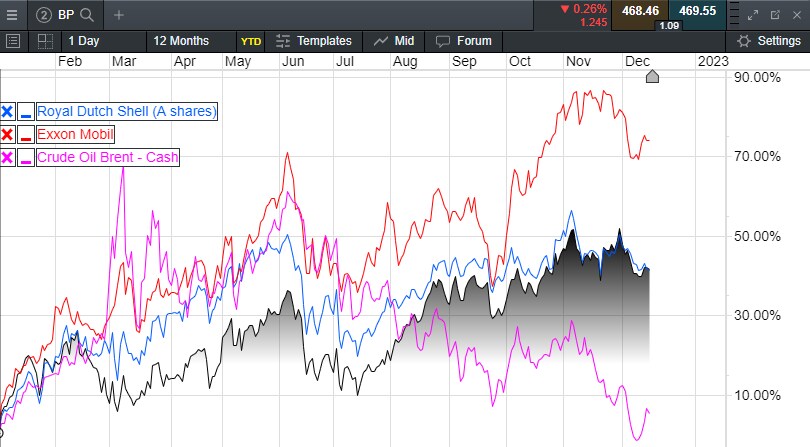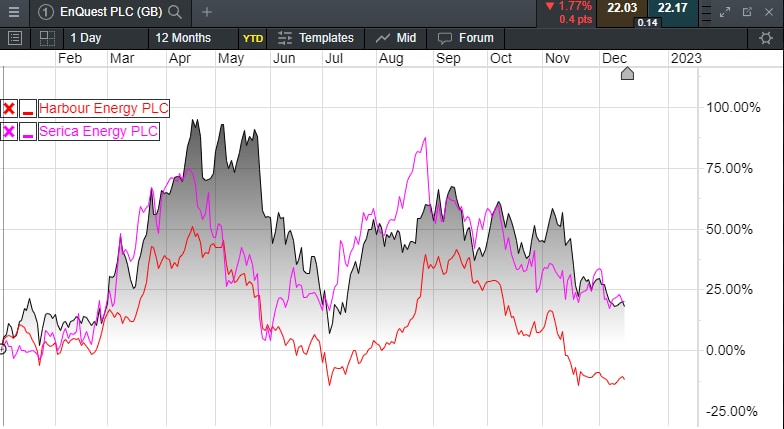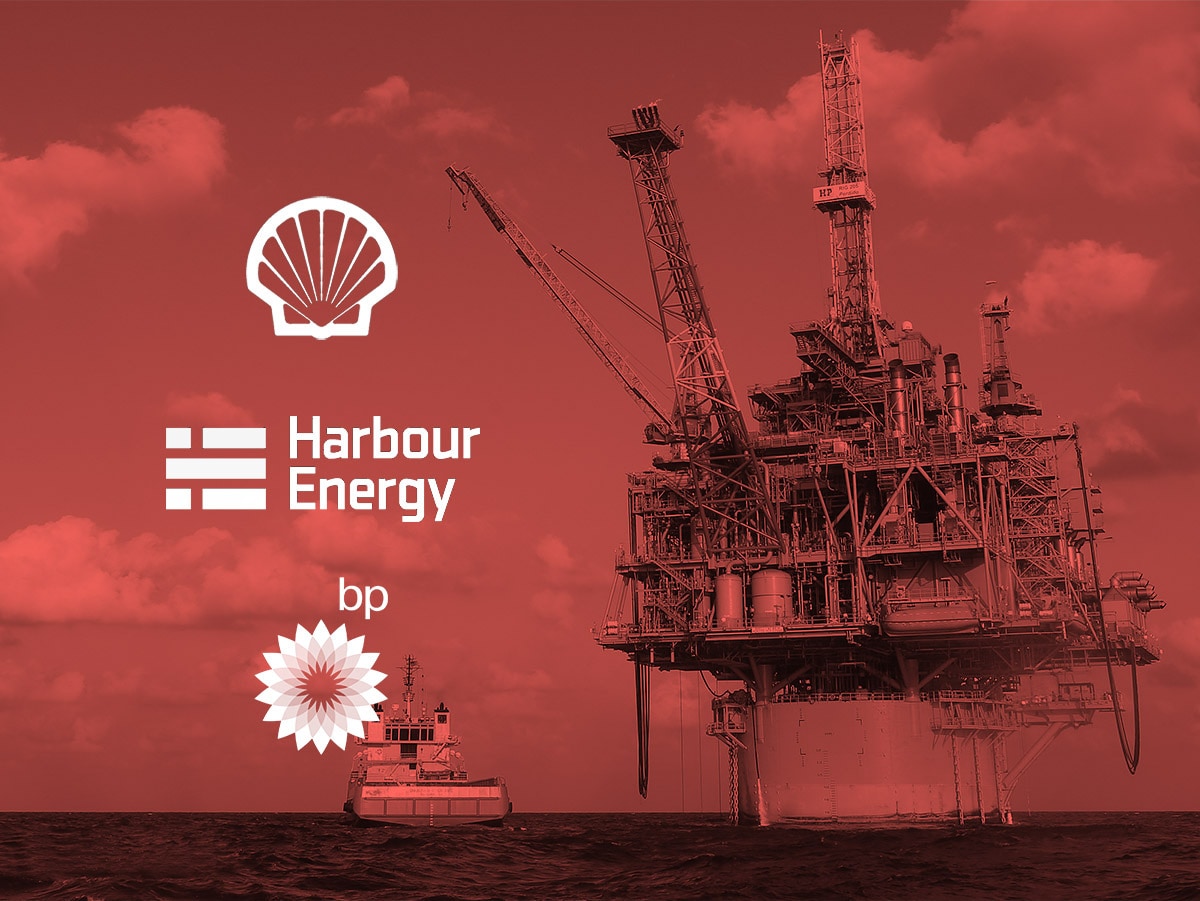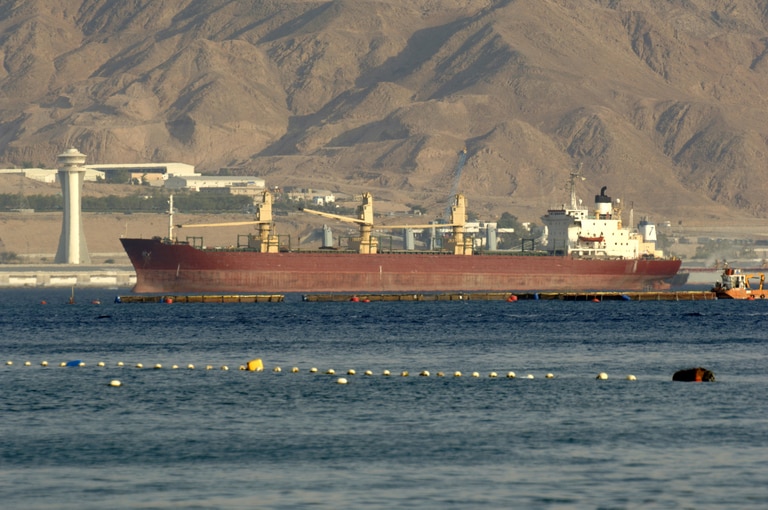When we looked at the oil and gas sector at the end of last year, it was undergoing a Lazarus-style comeback after what was a near death experience during 2020, caused by a wholesale collapse in energy prices after the shutdown of the global economy due to Covid-19 lockdowns.
Since then, we’ve seen prices rebound strongly partially due to lost capacity as a result of OPEC members slashing output to as low as 22.5m barrels a day in June 2020, and well below the levels of 32.9m barrels a day that were being pumped out in October 2018, as Brent crude prices bottomed at about $15 a barrel during April 2020.
Russian output also fell sharply during that period from a peak of just over 11.3m barrels a day, to a low of just below 9m, before undergoing a steady recovery to levels just above 10m at the end of last year, according to the EIA. Having been horribly burned in the early part of 2020 it would appear that neither OPEC or Russia wanted a repeat of the situation that saw the oversupply and price collapse that we saw during that period, as refinery and oil storage capacity almost ran out.
Some of the decisions that were made during that period have also played a part in the subsequent rebound in prices, in addition to the Russian invasion of Ukraine which acted as an additional tailwind for prices, and the current inflation surge that is causing such economic pain. We also saw the scrapping of new infrastructure projects, the highest profile of which was the cancellation by the Biden administration of the remainder of the Keystone pipeline in June 2021, which if completed would have linked Canada’s oil reserves, to US Gulf Coast refineries.
When we started this year oil prices had managed to recover back to $78 a barrel for Brent, while the rise in natural gas prices to record highs in Europe was also starting to garner attention as Russian president Vladimir Putin started to amass thousands of troops on Ukraine’s eastern and northern borders. With oil prices now back around $80 a barrel after peaking in the summer at $126 a barrel, OPEC+ appear to be compensating for that mistake in the opposite direction, with a reluctance to overly relax their hands on the tiller when it comes to restoring the output that was cut back in response to 2020’s sudden demand stop.
While the price and demand collapse dented the balance sheets of the oil producing countries, it also did immense damage to the balance sheets of the big oil major companies, losing as they did a combined $76bn between them. Around $70bn of that amount was as a result of writedowns and impairments on unviable or stranded assets, however the challenge for the likes of Exxon Mobil, BP and Royal Dutch Shell remains how they transition towards a renewable future without hammering their margins. They also have to try to appease the more extreme parts of the green lobby who it could be argued aren’t helping the situation with some of the most ridiculous demands when it comes to the transition towards renewable sources of energy.
While the majority of people understand the need to transition to more sustainable energy sources, the reality is that the world is ill-equipped to manage the sort of transition being demanded on the timetable required at an affordable rate, as can be seen from current prices due to the ineptitude of government energy policy over the last 25 years. Incentivising oil companies to mothball or close some of their most polluting assets is a laudable goal if you offset those capacity cuts with incentives to replace those assets with other less polluting solutions, along with a sustainable baseload for when the sun doesn’t shine and the wind doesn’t blow.
This was where LNG was supposed to come into the equation along with nuclear energy, none of which have seen the required investment to replace the likes of coal, oil and gas. This was no better illustrated by a recently unearthed clip of UK deputy PM at the time, Nick Clegg, pushing pack on the building of a nuclear power station in 2010, because it wouldn’t be ready by 2021. This short-sightedness perfectly encapsulates the political failures of the last 25 years, given we certainly could have done with that extra capacity now.
This lack of investment, along with the Russian invasion of Ukraine has caused prices to soar and politicians to turn around and accuse the oil and gas companies from profiteering, while at the same time imposing windfall taxes of up to 35% on top of an already high 40% tax rate. As an exercise in short termism, it signals everything that has gone wrong with western governments energy policy in the 21st century.
There is certainly a case for criticising oil companies for a lack of investment towards renewables and incentivising buybacks over future capex, but oil companies will only invest large amounts of capital or sunk costs if they have an expectation of a decent return, and a stable investment environment. Currently we have neither of those. This appears to be something that eludes the imagination of a lot of people, not only in politics, but also in the general population. Until that changes it will be extremely difficult if not impossible to be able to implement the sort of changes required, in the timeframe that is required.
Windfall taxes
Supporters of windfall taxes will inevitably point to the example of Equinor in Norway of how a high tax regime works well, and while it is true that Equinor does have an effective tax rate of 78%, and has also been highly profitable over the years, it is also 67% owned by the Norwegian government, which means Norwegian taxpayers also bear the brunt of any losses when they occur. It also means that they see both sides of the business cycle, sharing the downside risk as well as the upside benefits, which can bring about its own problems.
As we know from previous experience when taxpayers have to absorb large losses, politicians start to ask questions, as was the case in 2020, when Equinor lost $5.5bn, and had to sell some of its US assets, when oil prices went to zero. Over the last few years, the company has also had to write down over $20bn due to US investments that have gone bad.
In any case, what this windfall tax does take the benefits of past investment decisions, while adopting none of the risk, great for the government in the short term, not so good for the companies concerned. In the longer-term companies won’t invest the amounts of capital required to unlock these new projects if they then can’t reap the rewards when the resource comes on line.
Which brings us back to this year’s windfall taxes, which have taken the effective tax rate on UK energy companies to 75% on their UK profit. With respect to the likes of BP and Shell, their share prices have still gone from strength to strength, despite oil prices giving up all of their gains for this year.
Oil price relative to BP, Shell, Exxon share prices (year-to-date)

Source: CMC Markets
As we can see from the above graphic, we’ve seen a decent rebound in the share price of the oil majors, although it is notable that both BP and Royal Dutch Shell have moved in lockstep, both up over 35% year-to-date, although they have still underperformed Exxon, which has a bigger presence in the US and has fairly limited exposure to the windfall tax.
Fortunately for BP and Shell, the proportion of profits in the UK is quite small given that they are global companies, however the impact on the smaller companies which are UK based has been more substantial. The likes of Harbour Energy and EnQuest haven’t been so fortunate and makes the decision to impose the windfall tax so mind numbingly short-sighted.
We are already seeing the consequence of that decision, with Harbour Energy deciding not to bid for any new oil and gas licences, in what is a significant blow to the UK’s prospects of boosting its energy security in this new post-Russian aggression world.
UK small producers' performance (year-to-date)

Source: CMC Markets
Harbour Energy has been the biggest casualty of the decision to impose the windfall tax. Its shares were at one point over 90% up year-to-date, and have since fallen to their lowest levels since November 2020, causing it to fall out of the FTSE 100 in the process. The company has been on a rollercoaster journey, and has had a chequered history, formed out of the wreckage of Premier Oil and Chrysaor in April 2021.
Shareholders have had a torrid time over the past five years, as the company struggled to finance its operations in the North Sea, as it looked to unlock new resources like the Tolmount Gas field, which has seen the UK increase its gas output by 5%. Higher prices for natural gas would allow the company to recoup that investment, as well as look to unlock new capacity in UK waters where 90% of its production takes place through five key hubs, as well as pay down its legacy debt levels of $2.8bn.
The windfall tax will make this much more difficult, if not impossible, which helps explain Harbour’s decision not to bid for the new round of UK oil and gas licences, as well as reassessing its future investment plans in the North Sea. It’s a move that is not surprising but is also depressingly predictable. If you take the decision to overtax businesses, especially small ones, don’t be surprised if they choose to walk away.
In 2021 the company had annual revenues of $3.48bn, and this looks set to rise to $5.44bn in the current fiscal year, however it’s hard to envisage why the company would look at taking new steps to invest in UK waters given the current toxic tax environment. In July, the company reported some good news from its Indonesian Timpan exploration well, in which it reported a 390-foot gas column, with the prospect that it could be commercially profitable with the right amount of investment.
While the likes of Harbour Energy and other domestic producers have taken a beating, BP and Shell have seen strong performance this year. So how have BP and Shell managed their recovery process this year? It is certainly welcome that the rebound in oil and gas prices has helped boost the balance sheets of both businesses.
In 2020 BP was eventually forced to bow to the inevitable and cut its dividend to 5.25c a share, as well as announcing swingeing job cuts. Now as we look back on the last 12 months one must assess whether BP and Shell are doing enough to help with the transition towards renewables without hammering the very margins that allow them to return loads of cash to their shareholders. Both companies are already coming under pressure from an increasingly boisterous green lobby, as well as ESG investors to be more environmentally friendly, and become carbon neutral by the end of the decade.
In Q3 BP saw underlying replacement cost profit of $8.15bn, along with a pledge to buy back another $2.5bn of its shares. While the headline number is impressive in terms of how close it came to matching Q2’s performance, the actual profits attributable to shareholders is zero due to an accounting adjustment which pushed the company into a quarterly loss of $2.16bn. This adjustment came from its gas and low carbon energy unit which once again outperformed with profits of $6.24bn, however due to the volatility in forward gas markets and a repricing of forward gas prices, this has turned into a loss of $2.96bn. Its oil production and operations division returned $5.21bn in profits. On top of the Rosneft adjustment earlier this year that means BP has recorded a -$13.29bn loss so far year to date, but that inconvenient fact is likely to fly under the political radar.
BP has already set aside an $800m adjustment in their numbers in respect of the latest UK windfall tax, pushing the tax take from the North Sea to $2.5bn for this year. BP is also continuing to pay over $1.2bn a year in respect of the Gulf of Mexico oil spill. The company also spent $3.2bn on capital expenditure this quarter taking the total year to date to just shy of $9bn, while it revised its full year capex number up to $15.5bn.
On the outlook BP remains committed to using 60% of its surplus cash flow for share buybacks, and the remaining 40% to strengthen the balance sheet. Net debt also came down but only marginally to $22bn, which is down sharply from this time last year when it was $31.97bn. While the profit numbers continue to act as political catnip it is encouraging that BP is stepping up its capex investment albeit fairly modestly.
Spending on renewables is something that BP and Shell need to do much more of. In Q3, capex spending on low carbon energy came in at $86m, out of a total of $958m, in its gas and low carbon energy division, down from $142m in Q2, taking the total spend on low carbon this year to $447m, out of a total of $2.64bn. In oil production and operations total capex rose modestly to just shy of $1.4bn in Q3. At current prices Q4 profits are likely to see the debate about windfall taxes once again suck all of the oxygen out of any sort of long-term UK energy strategy, and while BP have given little indication that they will change their UK Investment plans, Shell has already said it is doing just that, while French oil company Total cut its plans to invest in the North Sea by 25% in 2023, or by £100m.
Shell’s numbers this year have also been impressive. In Q2 they posted a record quarter, while in their most recent Q3 numbers the company announced another $4bn buyback, on adjusted profits of $9.45bn, slightly below market expectations, with the company announcing yet another share buyback program, this one being to the tune of $4bn, and which should be completed by Q4. The dividend is also rising by 15%. This makes it $18.5bn in share buybacks so far year to date, and a 15% rise in dividends indicates where management priorities lie, however as an exercise in PR the current policy is likely to invite a firestorm of criticism from the usual suspects, even as Shell s effective tax rate on UK profits now sits at 75%, although they have as yet not paid any.
As in previous quarters the bulk of its profits have come from its upstream business and integrated gas business, although the gas business suffered on the back of a disappointing performance in its trading unit, with profits seeing a decline of 38% from the numbers we saw in Q2. The company maintained its guidance on capex at between $23bn and $27bn this year, however spending on renewables continues to be tiny relatively speaking to its investment elsewhere. To some extent that makes sense given that we’ve seen decisions made to develop the Jackdaw gas field in the North Sea, as well as approving a deal in Australia to approve a natural gas field there.
In Q1 Shell spent $5bn on capex, and $7bn in Q2, however of that $7bn, only $321m was spent on renewables down from $985m in Q1. In Q3 capex fell to $5.4bn, although of that we saw renewables rise investment to just over $1bn. The amount of profit renewables contribute to the bottom line continues to be tiny, $400m in Q3 down from $725m in Q2, however the increase in capex in Q3 is encouraging, making up 20% of overall spend in Q3.
If there’s one area where the narrative needs to shift it needs to happen here when it comes to investment in renewables as well as maintaining a solid baseload. This year we’ve seen a significant escalation in the antics of organisations like “Just Stop Oil” which have sucked the oxygen out of a more mature debate about how the global economy adapts to a changing climate while at the same time protecting the most vulnerable in society from sky high energy prices.
This isn’t a situation that will change in the medium term and for all the cant and hypocrisy of some of the narrative vilifying oil companies, they remain key parts of the global economy, given that oil and petroleum by-products are used in all manner of day to products, including clothing, tyres, car parts, and everyday items.
Demand for these items isn’t going to fall soon and will only increase as China full reopens next year. In the short term while BP and Shell need to get their debt levels down, they also need to show they are part of the solution, and that is something they appear to be struggling with. The reality is even if we were able to do what “Just Stop Oil” are asking it wouldn’t make a difference to global emissions, and would also drive the economy into an economic abyss.
BP is starting to spend more on renewables, albeit from a low base, but will need to spend a lot more if it wants to reach its highly ambitious target of 50GW by 2030. At the end of 2020 its current figure stood at 2.5GW. By comparison, Orsted, which is one of the world’s biggest providers of renewable energy of offshore wind, currently has a total of 13.7GW of installed capacity, with 6.2GW of that installed in the UK. This total is expected to increase to 50GW by 2030, by a combination of wind, solar and renewable hydrogen, at a cost of DKK350bn, or about $54bn. On that basis BP and Shell and everyone else have a long way to go, however that doesn’t mean we can’t continue to see the shares maintain their gains of the past couple of years.
Disclaimer: CMC Markets is an order execution-only service. The material (whether or not it states any opinions) is for general information purposes only, and does not take into account your personal circumstances or objectives. Nothing in this material is (or should be considered to be) financial, investment or other advice on which reliance should be placed. No opinion given in the material constitutes a recommendation by CMC Markets or the author that any particular investment, security, transaction or investment strategy is suitable for any specific person. The material has not been prepared in accordance with legal requirements designed to promote the independence of investment research. Although we are not specifically prevented from dealing before providing this material, we do not seek to take advantage of the material prior to its dissemination.








